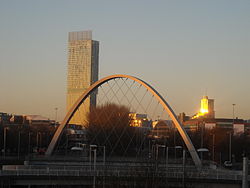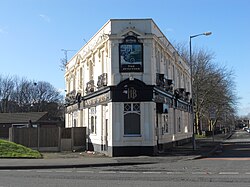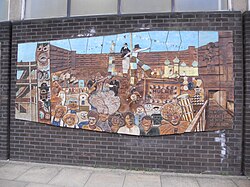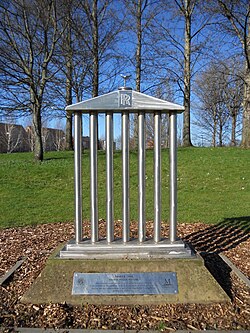Difference between revisions of "Hulme"
m (→Early history) |
(→Industrial Revolution) |
||
| Line 56: | Line 56: | ||
Hulme was also described by Engels: "the more thickly built-up regions chiefly bad and approaching ruin, the less populous of more modern structure, but generally sunk in filth."<ref name=engels /> | Hulme was also described by Engels: "the more thickly built-up regions chiefly bad and approaching ruin, the less populous of more modern structure, but generally sunk in filth."<ref name=engels /> | ||
| − | The Tithe award for Hulme was made in 1854.<ref>Frangopulo, N. J., ed. (1962) ''Rich Inheritance''. Manchester: Manchester Education Committee; p. 278</ref> In 1863 members of the Hulme Athenaeum club for working men established an association football club, believed to be the earliest example in the city and in | + | The Tithe award for Hulme was made in 1854.<ref>Frangopulo, N. J., ed. (1962) ''Rich Inheritance''. Manchester: Manchester Education Committee; p. 278</ref> In 1863 members of the Hulme Athenaeum club for working men established an association football club, believed to be the earliest example in the city and in Lancashire. <ref> Gary James & Dave Day (2014) ''The Emergence of an Association Football Culture in Manchester 1840–1884'', Sport in History, Vol 34, Issue 1, pp.49-74 http://www.tandfonline.com/doi/abs/10.1080/17460263.2013.873075?src=recsys </ref> Records of association games in the 1860s and 1870s exist with the club surviving into the early 1870s. |
The foundation stone of the first school erected by the Manchester School Board was laid in Vine Street, Hulme, on 11 June 1874 by Herbert Birley, chairman of the board, and the school was opened on 9 August 1875. Other board schools in Hulme were at Hamer Street (1872), Zion Chapel (1875), Lloyd Street (1878), Mulberry Street (1881), Upper Jackson Street (1883), Bangor Street (1886) and Duke Street (1890).<ref>Frangopulo, N. J., ed. (1962) ''Rich Inheritance''. Manchester: Manchester Education Committee; p. 89, 150</ref> | The foundation stone of the first school erected by the Manchester School Board was laid in Vine Street, Hulme, on 11 June 1874 by Herbert Birley, chairman of the board, and the school was opened on 9 August 1875. Other board schools in Hulme were at Hamer Street (1872), Zion Chapel (1875), Lloyd Street (1878), Mulberry Street (1881), Upper Jackson Street (1883), Bangor Street (1886) and Duke Street (1890).<ref>Frangopulo, N. J., ed. (1962) ''Rich Inheritance''. Manchester: Manchester Education Committee; p. 89, 150</ref> | ||
Latest revision as of 18:25, 27 September 2021
| Hulme | |
| Lancashire | |
|---|---|
 The Hulme Arch Bridge | |
| Location | |
| Grid reference: | SJ834963 |
| Location: | 53°27’49"N, 2°15’0"W |
| Data | |
| Population: | 16,907 (2011) |
| Post town: | Manchester |
| Postcode: | M15 |
| Dialling code: | 0161 |
| Local Government | |
| Council: | Manchester |
| Parliamentary constituency: |
Manchester Central |
Hulme is a south Lancashire town which has become an inner-city suburb of Manchester. It has a significant industrial heritage.
Contents
Name
Hulme derives its name from the Old Norse holmr, holmi, through Old Danish hulm or hulme meaning small islands or land surrounded by streams, fen or marsh.[1] The area may have fitted this description at the time of the Scandinavian invasion and settlement as it is surrounded by water on three sides by the rivers Irwell, Medlock and Corn Brook. Ekwall suggested that the considerable number of Danish names to the south and south-west of Manchester, unparalleled in the rest of Lancashire, pointed to a Danish colony on the north bank of the Mersey.[1]
History
Early history
Ouerholm and Noranholm were recorded in 1226 and Norholm in 1227. These are thought to be variations of Overhulm and Netherhulm, although recorded earlier.[1]
The surname de Hulm is known from records of 1246, 1273, 1277, 1285,[2] 1332 and 1339[3] and del Hulme from 1284.[2] There are other early Hulm(e)s/Holm(e)s from which they might have received their surnames (by Warrington and Lancaster, for example).
In 1310 there is a mention of "the manor of Hulm with the appurtenances, near Mamcestre".[3]
In 1322 in the records of rents of the lands of the recently executed enemy of the King and rebel Thomas, Earl of Lancaster, the following are mentioned as in the Salford Hundred:
"Geoffrey de Hulme holds half a ploughland in Hulme and renders yearly 5s[hillings]." or, in an alternate version: "Geoffrey de Hulme holds one ploughland in Hulme by the service of 5s. yearly at the 4 terms for all." and "John le Ware holds one ploughland in Hulme by the service of 5s. yearly at the 4 terms." In 1324 there is a record of "... ; farm of the land of Geoffrey de Hulme in Hulme which Jordan the dean formerly held in Overhulm and Netherhulm 5s ; ..."[4]
In 1440 there is a mention of the manor of Hulme and land exchanged for 200 pounds of silver: "Between William de Byrom, Henry de Par and John Hepe, late of Hulme, plaintiffs, and Ralph de Prestwich, deforciant of the manor of Hulme with the appurtenances, and of 9 messuages, 300 acres of land, 100 acres of meadow, 500 acres of pasture, and 100 acres of wood in Mamcestre, Crompton and Oldom.[3]
Hulme was evidenced as a separate community south of the River Medlock from Manchester in 15th century map prints. Christopher Saxton included Holme in his map of Lancashire of 1577 on the south banks of the Medlock and the Irwell where they joined. Trafford was placed on the south bank of the Irwell to the south-west, Wordsall across the Irwell to the north-west and Manchester across the Medlock to the north.[5]
Hulme Hall was close to the River Irwell on a site near where St George's Church was later built. Until the 18th century the area remained agricultural, and pictures from the time show an idyllic scene of crops, sunshine and country life. The area remained entirely rural until the Bridgewater Canal was cut and the Industrial Revolution swept economic change through the neighbouring district of Castlefield where the Duke of Bridgewater's canal terminated, and containerised transportation of coal and goods rose as an industry to support the growing textile industries of Manchester. It was this supply of cheap coal from the Duke's mines at Worsley that allowed the textile industry of Manchester to grow.
Industrial Revolution
The Industrial Revolution brought development to the area, and jobs to the poor, carrying coal from the 'starvationers' (very narrow canal boats), to be carted off along Deansgate.
Many cotton mills and a railway link to Hulme soon followed, and thousands of people came to work in the rapidly expanding mills in the city. The number of people living in Hulme multiplied 50-fold during the first half of the 19th century. Housing had to be built rapidly, and space was limited, which resulted in low-quality housing interspersed with the myriad smoking chimneys of the mills and the railway. Added to the lack of sanitation and rampant spread of disease, this gave an extremely low quality of life for residents. Reports of the time suggest that at times the air quality became so poor that poisonous fumes and smoke literally blocked out the sun for long periods.
In the Irish Poor Report of 1836 the Deputy Constable of the Township of Manchester, Joseph Sadler Thomas, found that the Irish were so fiercely neighbourly in Little Ireland (located on the other side of the River Medlock, and the larger Irish area of Angel Meadow (north-east of Manchester’s Victoria Station, on the other side of central Manchester from Hulme) that: "if a legal execution of any kind is to be made, either for rent or debt, or for taxes, the officer who serves the process almost always applies to me for assistance to protect him; and, in affording that protection, my officers are often maltreated by brickbats and other missiles".[6]
Hulme Hall was demolished in 1840 with the construction of the Bridgewater Canal.[7] By 1844, the situation had grown so serious that Manchester Borough Council had to pass a law banning further building. However, the thousands of slum homes that were already built continued to be lived in, and many were still in use into the first half of the 20th century.
Friedrich Engels was the heir of a German cotton manufacturer who had come to work for the Ermen & Engels factory in Weaste, Salford, three miles from Hulme though he worked in the firm's offices in Manchester. He made Little Ireland infamous throughout the world as a disastrous slum despite it being relatively short-lived (a little over 30 years) and other areas of Manchester having worse housing, poverty and disease.[8] Little Ireland was a small slum between Oxford Road, the Medlock and the railway serving Manchester Oxford Road Station,[9] mainly inhabited by Irish immigrant workers.[8] Described at length by Engels, he estimated that there was one inaccessible privy for every 120 residents. "The cottages are old, dirty and of the smallest sort, the streets uneven, fallen into ruts and in part without drains or pavement; masses of refuse, offal and sickening filth lie among standing pools in all directions; the atmosphere is poisoned by the effluvia from these, and laden and darkened by the smoke of a dozen tall factory chimneys. A horde of ragged women and children swarm about here, as filthy as the swine that thrive upon the garbage heaps and in the puddles."[10] Reinforcement of the Medlock to protect the factories raised the level of the river above the surrounding residential hovels leading to frequent flooding with filthy river water.[8] Hulme was also described by Engels: "the more thickly built-up regions chiefly bad and approaching ruin, the less populous of more modern structure, but generally sunk in filth."[10]
The Tithe award for Hulme was made in 1854.[11] In 1863 members of the Hulme Athenaeum club for working men established an association football club, believed to be the earliest example in the city and in Lancashire. [12] Records of association games in the 1860s and 1870s exist with the club surviving into the early 1870s.
The foundation stone of the first school erected by the Manchester School Board was laid in Vine Street, Hulme, on 11 June 1874 by Herbert Birley, chairman of the board, and the school was opened on 9 August 1875. Other board schools in Hulme were at Hamer Street (1872), Zion Chapel (1875), Lloyd Street (1878), Mulberry Street (1881), Upper Jackson Street (1883), Bangor Street (1886) and Duke Street (1890).[13]
In 1913 it was said "It is probable that in no northern city is the divergence between classes so marked as it is becoming in Manchester. Among the 80,000 inhabitants, for example, of Hulme, the poorest and most neglected district of the city, is to be found only a tiny minority of persons of much education and refinement, these being with rare exceptions doctors, or ministers of the various religious denominations, and their wives"[14]
In the early 20th century transport in Hulme was improved when the existing horse bus services were replaced by electric trams. These services connected Hulme with the suburbs further south.
Two theatres were built in Hulme, the Hulme Hippodrome and the BBC Playhouse. The Playhouse was for a short time opened as the Nia Centre but closed due to financial problems. The Hippodrome is still occupied in 2009.
After the Second World War
By the start of the 1960s England had begun to remove many of the 19th-century slums and consequently, most of the slum areas of Hulme were demolished. The modernist and brutalist architectural style of the period, as well as practicalities of speed and cost of construction dictated high rise "modular" living in tower blocks and "cities in the sky" consisting of deck-access flats and terraces.
In Hulme, a new and (at the time) innovative design for deck access and tower living was attempted. This consisted of curved rows of low-rise flats with deck access far above the streets, known as the Hulme Crescents (which were, with unintentional irony, architecturally based on terraced housing in Bath). In this arrangement, motor vehicles remained on ground level with pedestrians on concrete walkways overhead, above the smoke and fumes of the street. People living in these new flats were rehoused from decaying Victorian slums which lacked electricity, running water, bathrooms or indoor toilets, and were mostly overcrowded.
High-density housing was balanced with large green spaces and trees below, and the pedestrian had priority on the ground over cars. The 1960s redevelopment of Hulme split the area's new council housing into a number of sections. Hulme 2 was the area between Jackson Crescent and Royce Road. Hulme 3 was between Princess Road and Boundary Road based along the pedestrianised Epping Walk, Hulme 4 was between Princess Road and Royce Road and Hulme 5 - the "Crescents" themselves were between Royce Road and Rolls Crescent. The names of the "Crescents" harked back to the Georgian era, being named after architects of that time: Robert Adam Crescent, Charles Barry Crescent, William Kent Crescent and John Nash Crescent, together with Hawksmoor Close (a small straight block of similar design attached to Charles Barry Crescent). At the time, the "Crescents" won several design awards, and introduced technologies such as underfloor heating to the masses. They were also popular because they were some of the first council homes in Manchester to have central heating. The development even had some notable first occupants, such as Nico and Alain Delon.
What eventually turned out to be recognised as poor design, workmanship and maintenance meant that the crescents introduced their own problems. Design flaws and unreliable 'system build' construction methods, as well as the 1970s oil crisis meant that heating the poorly insulated homes became too expensive for their low income residents, and the crescents soon became notorious for being cold, damp and riddled with cockroaches and other vermin. Crime and drug abuse became significant problems in Hulme, as police did not patrol the long, often dark decks, due to the fact that they were not officially considered streets. The decks made muggings and burglary relatively easy, as any crime could be carried out in almost total privacy, with no hope for quick assistance from police below.
The crescents became troublesome very shortly after their construction—within a decade, they were declared 'unfit for purpose', and several plans were drawn up that suggested various differing types of renovation and renewal for the blocks, including splitting the buildings into smaller, more manageable structures by removing sections. In the 1980s and 1990s many of these vacant deck-access flats were squatted and the area acquired a 'Bohemian' reputation for its many punks, artists and musicians.
Parks
Public parks are St George's Park in the northwest and Hulme Park (29 acres) established near Jackson Crescent in 2000.[15]
Churches
- Church of England:
- The Church of the Ascension, built in 1970
- The Church of St George, a Commissioners' Church built in 1826–27. It was once the garrison church for the nearby Hulme Barracks as well as being the parish church of Hulme.[16] After being derelict for many years it has been converted to residential use.
- St Mary's Church, built 1856–58.[17] This too has been converted into apartments.
- Roman Catholic: St Wilfrid's
Industry
Nineteenth-century Hulme had some industry in the form of small workshops, but apart from the Knott Mill Iron Works owned by W & J Galloway & Sons on the banks of the Medlock, most large mills and other works were nearby in other townships, but providing employment for the people of Hulme. The chemical works of Roberts, Dale & Co. in Cornbrook was wrecked on 22 June 1887 by a large explosion which began in a stove drying prussic acid. Because the workers were at lunch there was only one fatality.[18]
Rolls-Royce
In 1884, Henry Royce started a domestic electric fittings factory at Cooke Street. He made three cars (the Royce 10) in a corner of what was his dynamo and electric crane workshops. In 1904, Royce and Charles Stewart Rolls created a business partnership after meeting at Manchester's Midland Hotel and started to build their own motor car (a relatively new invention). Hulme was the location of their first Rolls-Royce workshop, though operations were moved to Derby shortly afterwards. The Silver Ghost was designed and produced in Hulme. The Rolls-Royce V-8 was designed in Hulme in 1905 to compete with the popular electric town cars which were quiet, easy to start and free of smells, smoke and vibration.
Many names in Hulme commemorate this era, such as Royce Road, Rolls Crescent and the Bentley House Estate. The Royce public house, and occasional venue for music and stand-up comedy had a distinctive ceramic historical 'mural' but was razed for the creation of modern flats, in the 1990s regeneration of Hulme. In August 2007, "Temple 2000", a sculpture based on a Rolls Royce radiator grille by George Wyllie RSA MBE was unveiled in Hulme Park on the site of the old Royce factory at Cooke Street off Stretford Road. The artist was inspired by the memories of Hulme's older residents, many of whom worked at the factory.
Outside links
| ("Wikimedia Commons" has material about Hulme) |
References
- ↑ 1.0 1.1 1.2 Ekwall, Eilert: The Place-Names of Lancashire (1922)
- ↑ 2.0 2.1 Parker, John (Editor) "Lancashire Assize Rolls" Vol. XLIX (49), Part I, pp. 126, 145 (1903, The Record Society), Part II, pp. 189, 195, 205 (1905, The Record Society)
- ↑ 3.0 3.1 3.2 Farrer, William (Editor) "Final Concords of the County of Lancaster" Vol. XLVI (46), Parts I, II, III, (1899, 1903, 1905, The Record Society)
- ↑ Farrer, William (Editor) "Lancashire Inquests, Extents, and Feudal Aids" Vol. LIV (54), Part II, pp. 104, 106, 204 (1907, The Record Society)
- ↑ Saxton, Christopher LANCASTRIÆ, Comitatus palatin vera et absoluta descriptio Anno Dm 1577
- ↑ Busteed, M. A. and Hodgson, R. I. Angel Meadow: a Study of the Geography of Irish Settlement in Mid-Nineteenth Century Manchester, Manchester Geographical Society www.mangeogsoc.org.uk
- ↑ Farrer, William & Brownbill, J. (editors) "Hulme A History of the County of Lancaster - Volume pp 335–338: {{{2}}} (Victoria County History)
- ↑ 8.0 8.1 8.2 Busteed, Mervyn Exploring Greater Manchester: a fieldwork guide 3.1 Little Ireland (Web edition), Manchester Geographical Society
- ↑ http://goo.gl/maps/TGFwg
- ↑ 10.0 10.1 Engels, Friedrich The Condition of the Working Class in England, Chapter: "The Great Towns" German edition Leipzig 1845, English translation New York 1887, London 1891]
- ↑ Frangopulo, N. J., ed. (1962) Rich Inheritance. Manchester: Manchester Education Committee; p. 278
- ↑ Gary James & Dave Day (2014) The Emergence of an Association Football Culture in Manchester 1840–1884, Sport in History, Vol 34, Issue 1, pp.49-74 http://www.tandfonline.com/doi/abs/10.1080/17460263.2013.873075?src=recsys
- ↑ Frangopulo, N. J., ed. (1962) Rich Inheritance. Manchester: Manchester Education Committee; p. 89, 150
- ↑ Russell, Charles E. B. (1913) Social Problems of the North. London: A. R. Mowbray.
- ↑ Welcome to Hulme; Hulme Ward Coordination Template:Dead link
- ↑ Betjeman, J. (ed.) (1968) Collins Pocket Guide to English Parish Churches: the North. London: Collins; p. 158
- ↑ {{Pevsner|1|p=331>
- ↑ Makepeace, Chris (1995) Looking Back at Hulme, Moss Side, Chorlton on Medlock & Ardwick. Altrincham: Willow; pp. 44, 60
- Hathout, Sohair (1979) Privacy in Housing Design: environmental study in urban housing; study of the Hulme area, Manchester. Ph.D. thesis, University of Manchester, 1979
- The Hulme Advertiser, Chorlton-upon-Medlock and Stretford Observer 1870–71 (microfilm copy in British Library)
- Hulme Housing Association (1932) Housing in Hulme: a report. Manchester and Salford Better Housing Council
- Makepeace, Chris (1995) Looking Back at Hulme, Moss Side, Chorlton on Medlock & Ardwick. Altrincham: Willow
- Manchester City Council (1993) Report of the Housing and Public Health Committees on the proposed Hulme clearance scheme and the provision of rehousing accommodation for persons to be displaced in connection therewith. Manchester City Council
- Milligan, H. (1954) A Selection of Prints of the St George's Hulme and Wythenshawe Surveys.
- Potts, Bob (1997) The Old Pubs of Hulme and Chorlton-on-Medlock. Radcliffe: Neil Richardson
- Walsh, Vincent Stephen (1993) The Social Life of Hulme: politics and protest in an inner city housing estate. Ph.D. thesis, University of Manchester, 1993





